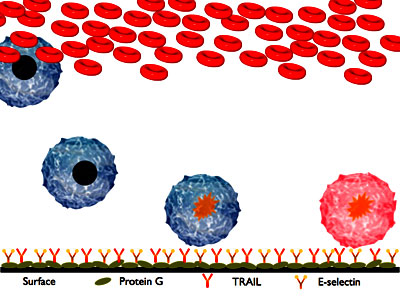A 'glue paper' is developed for cancer cells, capable of sitting in the blood vessels, attracting and trapping cancer cells in the blood and killing them before they have time to form new tumors in the body

In a study conducted at the University of Rochester and to be published in the Biotechnology and Bioengineering magazine, it was proven that two proteins found naturally in the body can be used to attract and kill up to thirty percent of cancer cells in the bloodstream - without harming healthy cells. The researcher, Michael King from Cornell University, developed a tiny tube coated with proteins. In principle, the tube can be implanted in one of the patient's blood vessels so that it filters and destroys the cancer cells that flow freely in the blood.
Although cancer tends to develop in specific tissues, there are types of cancer that are able to spread through the blood and form new cancerous metastases in healthy tissues. This is one of the deadliest and most difficult types of cancer to treat, because it is almost impossible to catch all the cancer cells that have managed to spread in the body. King's invention may provide a solution to a problem that good doctors have been embarrassed to face for the past decades.
King used molecules called selectins to capture the cancer cells. These proteins usually appear on the walls of blood vessels during inflammation and bind to them white blood cells traveling in the bloodstream. This binding allows the white blood cells to identify the areas of inflammation in the body, and to migrate out of the blood vessels to the damaged place, where they will fight the infection. King showed that he was able to coat the tube with selectins that would be able to attract and stick cancer cells to them as well.
Once the cancer cells adhered to the selectins in the tube, King exposed the selectins to a protein called TRAIL (Tumor Necrosis Factor Related Apoptosis-Inducing Ligand). This protein binds to two 'death receptors' on the cancer cell membrane and through them sends an unequivocal message into the cell: die, and quickly. Although the cancer cells have already lost most of their internal control mechanisms, they can still receive some of the instructions coming from the receptors, and as a result of activating the death receptors, a chain reaction that causes self-destruction begins in the cell. After activating the receptors, the TRAIL releases the cells back into the bloodstream, where they die - then the device is free to capture and kill new cells.
According to the latest research, the device is able to capture and kill approximately thirty percent of the cancer cells flowing through it, and has the potential to capture much more in the body's blood flow, which occurs in a closed circuit. King claims that in combination with routine cancer treatments, the device will be able to remove a significant amount of cancer cells from the blood, "and will give the body a chance to remove all other cancer cells."
The device's effectiveness was tested on cancerous prostate gland cells and colon cancer cells, but the same idea is expected to work on other cancer cells as well, by using different proteins to attract the cells and kill them. It seems that the device itself should be easy to implant - and even replace - inside a blood vessel, due to its minimal size.
"This has never been tried before. This is a new way of looking at cancer treatment," he adds. "Of course there is still a lot of work to be done before it really helps people - but that's how it all starts." Still, how far away is the vaccine from metastatic cancer? It seems that there are still several years before the device reaches the market. King admits that transferring the research to clinical application will take time and is still far from us. Still, he is optimistic about the future. "If you can reduce or prevent the development of metastases, just about any cancer can be treated."
Kuldeep Rana, a doctoral student at Cornell, and Jane Leiaswald, an MD at the University of Rochester, contributed to the writing of the article.

5 תגובות
This is really a thought-provoking direction for the fight against cancer, I have never come across such a way of looking at the problem, but is it enough?
What creative and inspiring solutions. Well done
It will be more effective - and the patient's blood can be transferred through it and returned filtered.
Let's say such a treatment every so often - let's say every 3 weeks a dose of chemotherapy is given - so before that filter the patient's blood with such an external filter - then give chemotherapy as well.
What creativity.
Regarding the question in the response above. It is likely that the release of cancer cells occurs over time.
If the cancer is carried in the blood like this and does not die immediately, then why is the patient's blood not immediately drained?